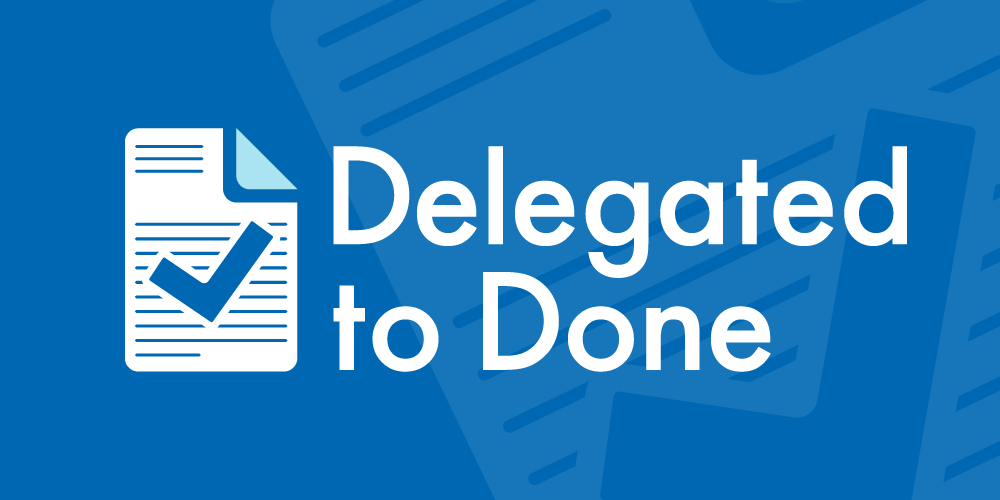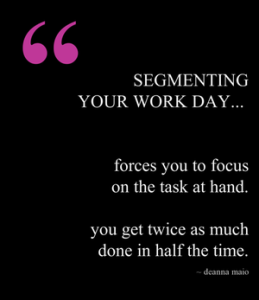Do you believe in multitasking? Numerous studies have proven that multitasking is a myth. You don’t actually get more done. In fact, you probably work more slowly because your brain has to continuously re-focus on each task. Scientists have discovered that the human brain can only focus on one thing at a time which means that multitasking should be called rapid sequential tasking or something along those lines because you’re really shifting focus back and forth to different tasks.
So why do people continue to multitask? Because it makes them feel good, and productive. According to a study conducted at The Ohio State University one study showed that multitasking often gave students an emotional boost, even when it hurt their cognitive functions. Segmenting your work day, may be another way to achieve the same satisfying benefits and get more accomplished.
What Does Segmenting Your Work Day Mean?
Segmenting means to divide into parts. In this case the parts are hours, or minutes. You probably do this to a certain extent when you schedule appointments on your calendar. You estimate that an appointment will take thirty minutes. However, most people don’t segment their daily work tasks. For example, they may sit down to write a blog post and write until he post is complete. Or, if they get satisfaction from multitasking they may write a blog post and check their email at the same time.
Why Segmenting Works
Segmenting is effective because it forces you to focus on the task at hand. For example, if you’re writing a blog post and you’ve allotted thirty minutes to write it then you’re not going to be as likely to surf the internet, check y our email or any other distractions or multitasks. You know you have thirty minutes to finish your task and you’ll work to achieve it in that length of time. It’s also quite satisfying to hammer through a task list and check things off. You’ll likely find that you get twice as much done in half the time.
Making Segmenting Work for You
To make segmenting work of you, you need to be able to do a few things. First, you need to be able to accurately assess the length of time it will take you to get something done. In the beginning, it’s wise to overestimate time so that you don’t get behind and discouraged. Additionally, you need to have some degree of self control to stick to your day’s plan. This can be helped by adding an incentive to the day. For example, if you get everything on your task list done on time you might treat yourself to an hour off to do whatever you’d like to do.
Segmenting your day can take some time to get used to, especially if you’re a long time multitasked. Give it a try. You’ll probably discover there’s a better, more enjoyable and more efficient way to spend your time.
 And now I would like to invite you to claim your Free Copy of my special report “7 Tips for Making the Most of your Work Time”
And now I would like to invite you to claim your Free Copy of my special report “7 Tips for Making the Most of your Work Time”
Yours free when you visit http://www.7TimeTips.com today.
You’ll learn:
- How and why to identify your most hated tasks.
- How to identify your biggest distractions – and eliminate them from your daily work life.
- Why setting goals is critical to your productivity success.
- The one thing you MUST do – even though it’s counter-intuitive – to ensure greater productivity.
- How to schedule tasks according to your own rhythms, so you can stop fighting with yourself and get more done.
- And much much more…
We all want to get more done – but few of us really take the time to plan our workflow and make it happen. Take the first step with this short report and discover what it’s like to be truly productive. Just visit http://7TimeTips.com
From Deanna Maio – Systems & Implementation Strategist http://DelegatedtoDone.com


Love the advice! I completely agree. When we multitask, sometimes we do so many things and what happens is we don’t get anything done. If we segment our work day by the alloting a specific time frame to accomplish certain tasks then we are able to do more.
I have never thought to segment my day i seem to waste so much time going around in circles. I plan to do this do that, but it never seems to happen. After reading your post and taking note of your sound advice i have managed to segment and time manage my day.Thanks so much.
I agree that multitasking doesn't always help to get more done. In fact, it can often be a distraction. It's better to break up your work day into time slots allotted for specific tasks.
your idea of doing large number of work at the same time is good. I realy like the way you divided the whole day. It will help me to enhance my multitasking skills. thanks
Can you be more specific about the content of your article? After reading it, I still have some doubts. Hope you can help me.
Thank you for your sharing. I am worried that I lack creative ideas. It is your article that makes me full of hope. Thank you. But, I have a question, can you help me?
Because the admin of this web page is working, no doubt very shortly it will be well-known, due to its quality contents.
You can certainly see your expertise within the article you write.
The sector hopes for even more passionate writers like you who aren’t afraid to say how they believe.
At all times go after your heart.